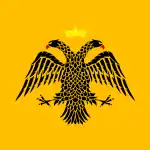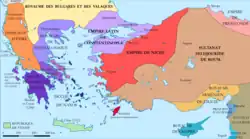| Lascaris Λάσκαρις Lascarid dynasty | |
|---|---|
| imperial dynasty | |
 | |
| Country | Byzantine Empire Empire of Nicaea |
| Place of origin | Constantinople |
| Founded | 1204[lower-alpha 1] (as imperial family) |
| Founder | Theodore I Laskaris |
| Final ruler | John IV Laskaris |
| Titles | |
| Deposition | 1261 (Empire of Nicaea) |
The House of Laskaris or Lascaris (Greek: Λάσκαρις, later Λάσκαρης; feminine form Laskarina, Λασκαρίνα) was a Byzantine Greek noble family which rose to prominance during the Late Byzantine period. The members of the family formed the ruling dynasty of the Empire of Nicaea, a Byzantine rump state that existed from the 1204 sack of Constantinople by the Fourth Crusade until the restoration of the Empire under the Palaeologan dynasty in 1261.
Upon the sack of the Byzantine capital by the Crusaders, Alexios V Doukas was overthrown and the Latin Empire was established in most of his former lands. Byzantine nobility would flee the Latin territories and establish the three independent Greek states that rivaled the Crusaders. After a successful resistance in Asia Minor, Theodore I Laskaris founded the Empire of Nicaea and laid claims to the Byzantine throne, along with the Angelos family of Epirus and the Komnenoi of Trebizond. The Byzantine Greek population of Asia Minor sought refuge to Theodore's empire, which gradually acquired control over much of western Anatolia. The empire was further strengthened after the military victories of Theodore's successor, John III Vataztes. John's son, Theodore II Laskaris, maintained the empire's strength until the throne was passed to his underage son, John IV Laskaris. In 1259 John fell victim to an aristocratic conspiracy which managed to establish Michael Palaiologos as his regent and co-emperor.[1][2]
The Nicaeans recaptured Constantinople in 1261 and Michael established the Palaiologos family as the new imperial dynasty. Under the Palaeologan rule, the Lascarids remained among the senior nobility up to the dissolution of the Byzantine empire, whereupon many of them emigrated to Italy and much later to Smyrna. According to George Pachymeres, a few members of the Laskarids were additionally called Tzamantouros (Tζαμάντουρος).[3]
Name
The origin of the name is unclear. In 1928, the Greek scholar Phaedon Koukoules proposed an origin from daskaris (δάσκαρης), a Cappadocian variant for "teacher", but the δ>λ shift in Cappadocian is attested only in the late 19th century, so that its application to the mid-11th century or earlier is dubious.[4] A year later, G. Stamnopoulos proposed an alternative etymology from the name Laskas (Λάσκας) or Laskos (Λάσκος) and the -aris (-άρις) ending borrowed from the Latin -arius, but the Greek linguist K. Menas considered such an etymological evolution as unlikely.[4] The Greek historian D. Theodoridis instead suggested a derivation from the Arabic al-ʿashqar, "ruddy, blond", or also "sorrel".[5] According to the Oxford Dictionary of Byzantium, the "most probable" etymology is the one proposed by B. Hemmerdinger in 1969, according to which the name derives from the Persian word Lashkarī (لشگری, also Arabic: عسکری, ʿaskarī), meaning "warrior, soldier". However, this interpretation is open to question since "the first known members of the Laskaris family [...] were simple peasants".[6][7]
History
Early members & Fourth Crusade
.jpg.webp)
The first occurrence of the name is in 1059, in a will by Eustathios Boilas, but the people mentioned there were simple peasants. Another family surnamed Laskaris appears in Thessalonica from c. 1180 on, but the relation with the imperial dynasty, if any, is unclear.[7]
The first Laskaris of note were Constantine and Theodore, the sons of Manuel Laskaris and Ioanna Phokaina Karatzaina (Greek: Ἰωάννα Φώκαινα Καράτζαινα). They also had three older brothers, Manuel, Michael and George, and two younger ones, Alexios and Isaac.[8] The Laskarids became prominent in Constantinople during the latter years of the Angelos dynasty, when Theodore had married Anna Komnene Angelina, a daughter of Alexios III Angelos.[9] Upon the sack of Constantinople on April 1204, the emperor Alexios V was blinded and taken captive by the Latins.[10] According to Niketas Choniates, as the Crusaders captured Constantinople on April 12, an emergency assembly was gathered in order to declare the new Byzantine emperor between Constantine Laskaris and Constantine Doukas. The former was elected emperor by the people, but eventually had to flee as the Latins arrived. Together with his brother Theodore, they led the anti-Latin resistance of the native Byzantine Greek population in Asia Minor, and it was Theodore who established a new empire in exile, the Empire of Nicaea.[10]
Empire of Nicaea
After the Byzantine capital fell to the Fourth Crusade in 1204, Theodore gathered a band of politically powerful refugees across the Bosporus in Asia Minor and formed a new Byzantine state. In the Empire of Nicaea the idea of Greek unification and restoration of the Byzantine rule was soon formed and strengthened.[11] Theodore defended his empire not only against the Crusaders but also against David Komnenos, a rival Greek emperor in Trebizond to the east on the Black Sea.[12] In 1205 Theodore assumed the title of emperor,[13] but he was officially crowned by the new patriarch in 1208. The coronation took place in the city of Nicaea; an event that turned the city into the center of the empire as well as of the Church.[14] During his reign Laskaris undertook the task of expanding the borders of his empire, facing the forces of the Latins and the Seljuks on several occasions, while at the same time laying the foundations of the internal administration of the newly formed state.[15]
Theodore I, whose sons, Nikolaos and John died c. 1212, was succeeded in 1222 by his son-in-law, John III Doukas Vatatzes, who had married Theodore's daughter Irene Laskarina.[16] Vatatzes had to fight off a rival claim by Isaac and Alexios, the brothers of Theodore I, who fled to the Latin Empire and sought aid. Vatatzes' victory at Poemanenum in 1224 however was decisive; it strengthened his own position and heralded a long and successful Nicaean offensive against the Latin holdings.[17] Throughout his reign, Vataztes' main rivals were the Bulgarian tsar Ivan Asen II and the Latin rulers of Constantinople to the west, as well as the Sultanate of Rum to the east. The Greek lords of Epirus and Trebizond, including Theodore Komnenos Doukas, were also Vatatzes' adversaries for the Byzantine throne.[17] Through a series of military victories, successful diplomacy, and beneficial policies, Vatatzes managed to significantly strengthen his empire, while also gaining popularity among the Byzantines which resulted in his canonization as a saint by the Orthodox Church.[17]
Vatatzes died in 1254 leaving his only son Theodore II Laskaris on the throne. Though his reign was short-lived compared to his predecessors, Theodore II was proven to be an able ruler and a man of letters.[18] During his four year reign he initiated a series of reforms aimed at curtailing the role of the aristocratic families in the internal affairs of the state. Theodore dismissed high officials of aristocratic origin and favoured local lineages of low birth. He was aware of the significance of the imperial office, and he personally administered the state.[19] Theodore II ruled until his death in 1258 leaving his eight year old son John IV Laskaris on the throne. A few days before his death, Theodore appointed the Laskarid loyalist George Mouzalon and perhaps Patriarch Arsenios as guardians and regents of John.[20] The aristocratic faction around Michael Palaiologos soon took control from George Mouzalon in a coup d'état, and installed Palaiologos as regent and, eventually, as co-emperor.[1] Following the recapture of Constantinople in 1261, Palaiologos was crowned alone as emperor, while John IV was ignored. Soon after, he was blinded and lived imprisoned until his death in c. 1305.[20]
Palaeologan era & Italy
Under the new Palaiologan dynasty, the Laskarids retained a certain prominence with several members of the family becoming local governors and courtiers. Among the most notable members are Manuel Laskaris, Domestic of the Schools c. 1320, and Alexios, a megas hetaireiarches c. 1370.[7] John Pegonites Laskaris was a composer who lived in Venetian-held Crete in the first half of the 15th century, while the scholars Constantine Lascaris and John Ryndakenos Laskaris were among the many who fled the fall of the Byzantine Empire to the Ottomans and found refuge in Italy,[7] where they helped spark the Renaissance. In the 15th century, Laskaris Kananos wrote an account of his travels in northern Europe.
In 1269 the Count of Ventimiglia, Gugliemo Pietro I Balbo married Eudossia Laskaris, daughter of Emperor Theodore II Laskaris.[21] From this union came the dynasty of the Lascaris of Tenda, who governed the sovereign County of Tenda until 1501 when the last of them, Anna Lascaris, married Renato of Savoy (in French René de Savoie) and transferred the County to his cadet branch of the Savoy dynasty. The most famous member of Ventimiglia branch of Lascaris was Giovanni Paolo Lascaris, Grand Master of the Knights of Malta. He constructed the Lascaris towers of Malta and attempted to create for Malta a Caribbean colonial empire.
Emperors of Nicaea
| Portrait | Name | Reign |
|---|---|---|
.png.webp) |
Theodore I Laskaris Θεόδωρος Λάσκαρις |
May 1205 – November 1221 (16 years and 6 months) |
.png.webp) |
John III Vatatzes Ἰωάννης Βατάτζης |
December 1221 – 3 November 1254 (32 years and 11 months) |
.png.webp) |
Theodore II Laskaris Θεόδωρος Λάσκαρις |
3 November 1254 – 16 August 1258 (3 years, 9 months and 13 days) |
.png.webp) |
John IV Laskaris Ἰωάννης Λάσκαρις |
16 August 1258 – 25 December 1261 (3 years, 4 months and 9 days) |
Family tree
| House of Laskaris | ||||||||||||||||||||||||||||||||||||||||||||||||||||||||||||||||||||||||||||||||||||||||||||||||||||||||||||||||||||||||||||||||||||||||||||||||||||||||||||||||||||||||||||||||||||||||||||||||||||||||||||||||||||||||||||||||||||||||||||||||||||||||||||||||||||||||||||||||||||||||||||||||||||||||||||||||||||||||||||||||||||||||||||||||||||||||||||||||||||||||||||||||||||||||||||||||||||||||||||||||||||||||||||||||||||||||||||||||||||||||||||||||||||||||||||||
|---|---|---|---|---|---|---|---|---|---|---|---|---|---|---|---|---|---|---|---|---|---|---|---|---|---|---|---|---|---|---|---|---|---|---|---|---|---|---|---|---|---|---|---|---|---|---|---|---|---|---|---|---|---|---|---|---|---|---|---|---|---|---|---|---|---|---|---|---|---|---|---|---|---|---|---|---|---|---|---|---|---|---|---|---|---|---|---|---|---|---|---|---|---|---|---|---|---|---|---|---|---|---|---|---|---|---|---|---|---|---|---|---|---|---|---|---|---|---|---|---|---|---|---|---|---|---|---|---|---|---|---|---|---|---|---|---|---|---|---|---|---|---|---|---|---|---|---|---|---|---|---|---|---|---|---|---|---|---|---|---|---|---|---|---|---|---|---|---|---|---|---|---|---|---|---|---|---|---|---|---|---|---|---|---|---|---|---|---|---|---|---|---|---|---|---|---|---|---|---|---|---|---|---|---|---|---|---|---|---|---|---|---|---|---|---|---|---|---|---|---|---|---|---|---|---|---|---|---|---|---|---|---|---|---|---|---|---|---|---|---|---|---|---|---|---|---|---|---|---|---|---|---|---|---|---|---|---|---|---|---|---|---|---|---|---|---|---|---|---|---|---|---|---|---|---|---|---|---|---|---|---|---|---|---|---|---|---|---|---|---|---|---|---|---|---|---|---|---|---|---|---|---|---|---|---|---|---|---|---|---|---|---|---|---|---|---|---|---|---|---|---|---|---|---|---|---|---|---|---|---|---|---|---|---|---|---|---|---|---|---|---|---|---|---|---|---|---|---|---|---|---|---|---|---|---|---|---|---|---|---|---|---|---|---|---|---|---|---|---|---|---|---|---|---|---|---|---|---|---|---|---|---|---|---|---|---|---|---|---|---|---|---|---|---|---|---|---|---|---|---|---|---|---|---|---|---|---|---|---|---|---|---|---|---|---|---|---|---|---|---|---|---|---|---|---|---|---|---|---|---|---|---|---|---|---|---|---|---|---|---|---|---|---|---|---|---|---|---|---|---|---|---|---|---|---|---|---|---|---|---|---|---|
| ||||||||||||||||||||||||||||||||||||||||||||||||||||||||||||||||||||||||||||||||||||||||||||||||||||||||||||||||||||||||||||||||||||||||||||||||||||||||||||||||||||||||||||||||||||||||||||||||||||||||||||||||||||||||||||||||||||||||||||||||||||||||||||||||||||||||||||||||||||||||||||||||||||||||||||||||||||||||||||||||||||||||||||||||||||||||||||||||||||||||||||||||||||||||||||||||||||||||||||||||||||||||||||||||||||||||||||||||||||||||||||||||||||||||||||||
See also
References
- ↑ Constantine Laskaris was elected Byzantine emperor in 1204. After the sack of Constantinople, Theodore was proclaimed emperor of Nicaea in 1205 and he was officially crowned in 1208.
- 1 2 Vasiliev 1964, pp. 506–508.
- ↑ "Empire of Nicaea | Britannica". www.britannica.com. Retrieved 2023-09-11.
- ↑ Angelov 2019, p. 17.
- 1 2 Theodoridis 2004, p. 269.
- ↑ Theodoridis 2004, pp. 271–273.
- ↑ Theodoridis 2004, p. 270.
- 1 2 3 4 ODB, "Laskaris" (A. Kazhdan & A. Cutler), p. 1180.
- ↑ Angelov 2019, p. 16.
- ↑ Angelov 2019, p. 19.
- 1 2 Angelov 2019, p. 22.
- ↑ Vasiliev 1964, p. 507.
- ↑ "Theodore I Lascaris | Britannica". www.britannica.com. Retrieved 2023-09-12.
- ↑ Angelov 2019, p. 27.
- ↑ Vasiliev 1964, pp. 511–512.
- ↑ Vougiouklaki 2003, p. Chapter 1.
- ↑ Vasiliev 1964, p. 508.
- 1 2 3 Guentcho 2002.
- ↑ "Theodore II Lascaris | Britannica". www.britannica.com. Retrieved 2023-09-12.
- ↑ Guentcho, Banev. "Theodore II Lascaris". asiaminor.ehw.gr. Foundation of the Hellenic World. Retrieved 2023-09-12.
- 1 2 Giarenis 2006.
- ↑ W.A.B. Coolidge, "The History of the Col de Tenda", The English Historical Review, 31 (1916), p. 202.
Sources
- Angold, Michael (2011). "The Latin Empire of Constantinople, 1204–1261: Marriage Strategies". Identities and Allegiances in the Eastern Mediterranean after 1204. Farnham: Ashgate Publishing. pp. 47–68. ISBN 9781409410980.
- Kazhdan, Alexander, ed. (1991). The Oxford Dictionary of Byzantium. Oxford and New York: Oxford University Press. ISBN 0-19-504652-8.
- Ostrogorsky, George (1956). History of the Byzantine State. Oxford: Basil Blackwell.
- Theodoridis, Dimitri (2004). "Die Herkunft des byzantinischen Familiennamens Λάσκαρις". Revue des études byzantines. 62: 269–273. doi:10.3406/rebyz.2004.2298.
- Vasiliev, Alexander (1964). History of the Byzantine Empire, 324–1453, Volume II. University of Wisconsin Press. ISBN 0299809269.
- Angelov, Dimiter (2019). The Byzantine Hellene, The Life of Emperor Theodore Laskaris and Byzantium in the Thirteenth Century. Cambridge University Press. ISBN 9781108480710.
- Guentcho, Banev (2002). "John III Vatatzes". Encyclopaedia of the Hellenic World, Asia Minor. Foundation of the Hellenic World.
- Giarenis, Ilias (2006). "John IV Laskaris". Encyclopaedia of the Hellenic World, Asia Minor. Foundation of the Hellenic World.
- Vougiouklaki, Pinelopi (2003). "Theodore I Laskaris". Encyclopaedia of the Hellenic World, Asia Minor (in Greek). Foundation of the Hellenic World.
